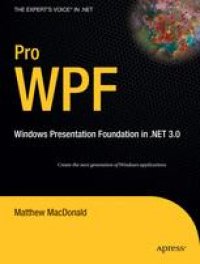
Ebook: Pro WPF: Windows Presentation Foundation in .NET 3.0
Author: Matthew MacDonald (auth.)
- Genre: Computers // Programming: Programming Languages
- Tags: Programming Techniques
- Year: 2007
- Publisher: Apress
- Language: English
- pdf
The Microsoft Windows Presentation Foundation (formerly code named "Avalon") is a key part of .NET 3.0 and provides the foundation for building applications and high quality user experiences in Windows Vista. It is likely to see wide adoption across the Microsoft .NET programming community.
WPF blends together user-interface design, documents, and media content, while exploiting the full power of your computer for the first time (it is able to write output directly to your computer’s graphics card).
This book explains how WPF works from the ground up. It will be one of the first books available, and also one of the most detailed. It follows on from the author’s previous and highly successful books covering Windows Forms (WPF’s predecessor technology). It is a one-stop shop in Apress’ proven ‘Pro’ style that leaves readers with a deep understanding of the technology and able to take the concepts away and apply them for themselves.
The Microsoft Windows Presentation Foundation (formerly code named "Avalon") is a key part of .NET 3.0 and provides the foundation for building applications and high quality user experiences in Windows Vista. It is likely to see wide adoption across the Microsoft .NET programming community.
WPF blends together user-interface design, documents, and media content, while exploiting the full power of your computer for the first time (it is able to write output directly to your computer’s graphics card).
This book explains how WPF works from the ground up. It will be one of the first books available, and also one of the most detailed. It follows on from the author’s previous and highly successful books covering Windows Forms (WPF’s predecessor technology). It is a one-stop shop in Apress’ proven ‘Pro’ style that leaves readers with a deep understanding of the technology and able to take the concepts away and apply them for themselves.
Content:
Front Matter....Pages i-xviii
Introducing WPF....Pages 1-18
XAML....Pages 19-51
The Application....Pages 53-82
Layout....Pages 83-121
Content....Pages 123-142
Dependency Properties and Routed Events....Pages 143-183
Classic Controls....Pages 185-220
Windows....Pages 221-248
Pages and Navigation....Pages 249-291
Commands....Pages 293-319
Resources....Pages 321-352
Styles....Pages 353-369
Shapes, Transforms, and Brushes....Pages 371-412
Geometries, Drawings, and Visuals....Pages 413-447
Control Templates....Pages 449-492
Data Binding....Pages 493-546
Data Templates, Data Views, and Data Providers....Pages 547-592
Lists, Trees, Toolbars, and Menus....Pages 593-636
Documents....Pages 637-688
Printing....Pages 689-720
Animation....Pages 721-774
Sound and Video....Pages 775-799
3-D Drawing....Pages 801-842
Custom Elements....Pages 843-890
Interacting with Windows Forms....Pages 891-913
ClickOnce Deployment....Pages 915-931
Back Matter....Pages 933-980
The Microsoft Windows Presentation Foundation (formerly code named "Avalon") is a key part of .NET 3.0 and provides the foundation for building applications and high quality user experiences in Windows Vista. It is likely to see wide adoption across the Microsoft .NET programming community.
WPF blends together user-interface design, documents, and media content, while exploiting the full power of your computer for the first time (it is able to write output directly to your computer’s graphics card).
This book explains how WPF works from the ground up. It will be one of the first books available, and also one of the most detailed. It follows on from the author’s previous and highly successful books covering Windows Forms (WPF’s predecessor technology). It is a one-stop shop in Apress’ proven ‘Pro’ style that leaves readers with a deep understanding of the technology and able to take the concepts away and apply them for themselves.
Content:
Front Matter....Pages i-xviii
Introducing WPF....Pages 1-18
XAML....Pages 19-51
The Application....Pages 53-82
Layout....Pages 83-121
Content....Pages 123-142
Dependency Properties and Routed Events....Pages 143-183
Classic Controls....Pages 185-220
Windows....Pages 221-248
Pages and Navigation....Pages 249-291
Commands....Pages 293-319
Resources....Pages 321-352
Styles....Pages 353-369
Shapes, Transforms, and Brushes....Pages 371-412
Geometries, Drawings, and Visuals....Pages 413-447
Control Templates....Pages 449-492
Data Binding....Pages 493-546
Data Templates, Data Views, and Data Providers....Pages 547-592
Lists, Trees, Toolbars, and Menus....Pages 593-636
Documents....Pages 637-688
Printing....Pages 689-720
Animation....Pages 721-774
Sound and Video....Pages 775-799
3-D Drawing....Pages 801-842
Custom Elements....Pages 843-890
Interacting with Windows Forms....Pages 891-913
ClickOnce Deployment....Pages 915-931
Back Matter....Pages 933-980
....